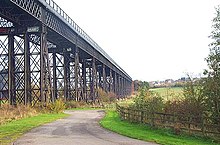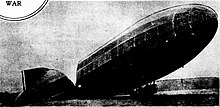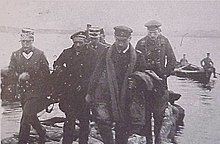Zeppelin LZ 59
Silhouette of LZ 59 (L 20)
| |
| History | |
|---|---|
| Name | LZ 59 |
| Operator | Imperial German Navy |
| Builder | Luftschiffbau Zeppelin |
| Laid down | 1915 |
| Launched | 1915 |
| Completed | 21 November 1915 |
| Acquired | November 1915 |
| Maiden voyage | 21 December 1915 |
| In service | 21 December 1915 |
| Out of service | 3 May 1916 |
| Identification | L 20 |
| Nickname(s) | Raider of Loughborough |
| Fate | Stranded due to fuel exhaustion on 3 May 1916 |
| General characteristics | |
| Class and type | Type Q |
| Type | Airship |
| Tonnage | 23,852 kg |
| Tons burthen | 17,500 kg of cargo |
| Length | 178.5 metres (585 ft 8 in) |
| Beam | 18.7 metres (61 ft 4 in)ø |
| Installed power | Four 240 hp Maybach HSLu engines[3] |
| Propulsion | 4 Lorenzen propellors |
| Speed | 95 km/h[2] |
| Range | 4,900 kilometres (3,000 mi)[1] |
| Capacity | 35,800 m³ Gas Volume in 18 gas cells |
| Crew | 18 |
| Aviation facilities | 2 gondolas |

The LZ 59 (L 20) was a
Construction
The LZ 59 was built by
War career
The LZ 59 conducted its first flight on 21 December 1915 from
on 6 April 1916.Bombing raids on the English Midlands
The LZ 59 conducted its first bombing raid on Britain on the night of 31 January and 1 February 1916. The ship took off together with L 19 from
LZ 59 dropped 7 highly explosive bombs on the railway junction at the

LZ 59 flew 40 kilometres (25 mi) westward and bombarded
As the night passed, all of the airships were ordered to return to their bases. In the end, none of the nine airships reached
After the air raid LZ 59 was given the nickname Raider of Loughborough due to the city's damage and the high death toll.[citation needed]
May 1916 bombing raid and crash
LZ 59 started its second bombing raid on Britain during the night of 2 May and 3 May 1916. The ship left its base in Tønder and joined 6 other airships to conduct another bombing raid against a number of factories, smelters and railways in Middlesbrough, Stockton-on-Tees and Hartlepool in northeast England. Another target for the airships were some enemy warships at the mouth of the Firth of Forth near Edinburgh, Scotland.[16]
After the air raid the airships returned safely to their bases except LZ 59, which was having problems with one of its four engines and also encountered strong winds from the southeast, which increased to a moderate gale. The wind blew the ship north past

The airship passed west of
Aftermath
On 4 May 1916 at 9:00 am the wind turned toward the northeast and drove the wreck of the airship towards the stone coast of Sør-Sunde. As a result, the gondola and motors were crushed and the ship's machine guns fell into the water. In order to prevent the ship from doing any damage to the nearby towns, Norwegian Colonel Johannesen summoned 12 soldiers who, at 3:00 pm, fired at the wreckage from a distance of 120 metres (393 ft 8 in), igniting the remaining hydrogen in a massive explosion.[19]

Internment of the crew
Some of the crew were interned on the German

Legacy
The LZ 59 will always be remembered as the Raider of Loughborough to the people of Britain.[citation needed] The airship dropped a total of 2,864 kg (6,314 lb) of bombs during its two raids and killed an estimated 17 people, as well as damaging many buildings. It made a total of 19 flights, covering a distance of 7,211 km (4,481 mi; 3,894 nmi).[21]
References
- ^ "LZ59 (L20)". air-ship.info. Retrieved 27 December 2016.
- ^ "Zeppelin LZ59- L20". wwi.hut2.ru. Archived from the original on 5 October 2017. Retrieved 27 December 2016.
- ^ "Luftschiff/Airships". globalsecurity.org. 11 July 2011. Retrieved 27 December 2016.
- ^ "Sterowce Zeppelin 1900–39". zeppelin.mariwoj.pl. Retrieved 27 December 2016.
- ^ "1916". flightglobal.com. 2010. Retrieved 27 December 2016.
- ^ "Zeppelin L 20". zeppelin-museum.dk. Retrieved 27 December 2016.
- ^ "Luftschiffe in Tondern". zeppelin-museum.dk. August 2003. Archived from the original on 14 August 2017. Retrieved 27 December 2016.
- ^ "Lz59 – L20". phpnet.org. 2000. Archived from the original on 5 March 2016. Retrieved 27 December 2016.
- ^ "The Zeppelin Airships". pugetairship.org. 2007. Retrieved 27 December 2016.
- ^ "Air Raids" (PDF). The Voice of Trent Valley Aviation Society. Archived from the original (PDF) on 22 July 2011. Retrieved 24 January 2009.
- ^ "Zeppelin Attack". The Friends of Bennerley Viaduct. Retrieved 1 February 2022.
- ^ "Zeppelin Raids on Nottinghamshire". greatwarforum. 4 January 2014. Archived from the original on 27 December 2016. Retrieved 25 September 2018.
- ^ "The First World War On The Her" (PDF). leics.gov.uk. 2014. Retrieved 27 December 2016.
- ^ "Bygones: Terror rained down from the night sky as Zeppelin pilots attacked Burton in mistake ... for Liverpool". Derby Telegraph. 5 May 2014. Archived from the original on 31 October 2014. Retrieved 27 December 2016.
- ISBN 9781473818927. Retrieved 27 December 2016.
- ^ "The Zeppelin Raid". Otago Daily Times. 6 May 1916. Retrieved 27 December 2016.
- ^ "Bydelens historie". hinnavis.no. 11 February 2011. Archived from the original on 20 February 2021. Retrieved 27 December 2016.
- ^ "Storkrigen strandet i Hafrsfjord". Stavanger Aftenblad. Archived from the original on 27 December 2016. Retrieved 27 December 2016.
- ^ "Zeppelineren L20". karolius.info. Retrieved 27 December 2016.
- ^ "The Zeppelins". 456fis.org. 2 October 2014. Retrieved 27 December 2016.
- ^ "Zeppelin L20". loughborough-rollofhonour.com. Retrieved 27 December 2016.
